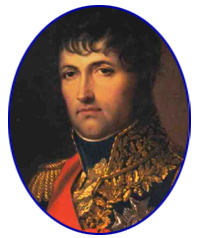

Click to see full text of the Chapter victor_ivanov@ukr.net
Argument of the Chapter
ōMarshal Nicolas Jean de Dieu Soult"
Early years. Service in the Saint-Jean-dÆAngely infantry regiment. Revolution. Promotion. Soult as a officer - instructor of Upper Rhein volunteer battalion. Soult as a adjutant-major. Campaign of 1793. Transfer to the Mosel Army of general Hoche. First victory at Landau. Campaign of 1794. Battle at Lukner. Participation in the battle at Flerus. Conflict with general ╠Órceu. Grade of the brigadier general.
Campaign of 1796. Successful fights at Altenkirchen, Lahn, Friedberg. Fight for the Ukerath emplacement. Leapfrog of new service purposes. Campaign of 1799. Battle at Ostrach. Soult as a division commander. Division general. Transfer to the Helvetian Army of general Massena. Successful fight of Soult and Oudinot against Austrians at Frauenfeld. Suppression of revolt in the Swiss cantons. Victory at Uster. The Second Swiss campaign. Plan of Austrian offensive. Defeat of the HotzeÆs Corp. Antagonism of Soult and Suvorow in the Alps. Transiting in the Italian Army of Massena.
Italian campaign of 1800. Strategic plans of the sides. Victory at Monte-Ormetta. Failure at Santa-Giustma. Attachment to main forces of Massena. The heroic defense of Genoa. Wound and captivity. Favour of Napoleon. Soult as the commander-in-chief of occupying armies in Piedmont. Intrusion into the Neapolitan kingdom. Soult as a general - colonel of the Consular Guards light infantry. Commandant of military camp Saint-Omer. A skilful management of the Ocean Army camps. An accident with the NapoleonÆs sculpture. MarshalÆs baton.
The Austrian campaign of 1805. The way from Rhein to Danube. Battle at Austerlitz. The plan of Veyroter and the plan of Napoleon. The main role of Soult in the victory at └usterlitz. "Jump of Lion". "I remember only └usterlitz". Prussian campaign of 1806. Battle at Jena. Defeat of the reserve Corps of Ruchel. The operational plans for campaign of 1807. Fight at Ionkovo. Battle at Preussisch-Eylau. Unexpected skirmish with the enemy on the eve of decisive battle. Holding down attack of Russian right flank. Fight at Heilsberg. Occupation of Koenigsberg.
The Spanish campaign. The title of Duke of Dalmatia. Landing of the British Corps in Portugal. of Wellington. The comparative characteristic of British and French tactics. General strategic situation on the beginning of battle actions. Situation and plans of the parties. Capture of Burgos fortress. Crashing the BlakeÆs army at Espinoza. Victory at Gamonal. Capture of Santarder fortress. Crossing the Samossierra pass. The Polish uhlans. Occupation of Coruna and port of Ferrol. ╠oorÆs maneuvers aimed at defeat of the marshal SoultÆs Corp. Fight for the port of Corogne. Heroic death of British commander Moor.
Intrusion into Portugal. A march to the river Minho. Capture of Braga fortress. Wellington heads the incorporated Spanish-British army. Siege of ╬porto. Description of the fortress. A case with the general Foy. Capture of the city. Intentions of marshal Soult to take the Portuguese throne. WellingtonÆs maneuvers against the communications of Soult. Defeat at ╬porto. The common analysis of the Portuguese campaign of marshal Soult. Retreat in Spain. The hasty decision of the king Joseph to give the battle under ęÓlavera. Marshal Soult as the new commander of all the French forces in Spain. Victory at ╬kania. Under the authority of marshal Massena. Languid siege of Cadix. Suppression of rebellion in Andalusia. Siege of Oliventza fortress. Siege of Badajoz fortress. The description of the fortress. Battle at └lbufera. Siege of Tarifa. The persistent defense of Badajoz.
Evacuation of Andalusia. Short holiday at home. Participation in the Bautzen battle. Defense of southern French boundaries from the intrusion of Wellington. Defensive battle at Sourauren. Forces of the parties before final duel. Resoluteness of the general Closel. A defense of Saint-Sebastian fortress. Defeat at Bidassoa.
Intrusion of Wellington into France. Defeat at ╬rthez. Defense of Toulouse. Transition to the side of Louis XVIII. Marshal Soult as Õhe chief of NapoleonÆs Army staff during the One Hundred Days. Marshal SoultÆs inexperience in staff work. Defeat at Waterloo. Career during the Second Restoration. Death. The analysis of military leaderÆs career of marshal Soult.
Maps of the Chapter ōMarshal Nicolas Jean de Dieu Soult"
1. Central Europe (October 11-14, 1805).
2. Battle at Austerlitz (general conditions).
3. Napoleon's use of mixed order in the Battle of Austerlitz.
4. Battle at Jena ¢ Auerstaedt.
5. The main phases of Jena battle.
6. Polish campaign, 1807.
7. Maneuvers at Heilsberg.
8. Battle at Heilsberg ( phase 1).
9. Battle at Heilsberg (phase two).
10. Spanish campaign, 1808-1814.
11. Battle at Rolica.
12. Portugal, 1808.
13. Battle at Gamonal.
14. Battle at La Corogne.
15. Battle at Braga.
16. Actions at Oporto (March ¢ May, 1809).
17. Battle at Ocana.
18. Spain, 1808-1810.
19. Battle at Albufera.
20. Battle at Tarifa.
21. Battle at Maya.
22. San-Sebastien fortess.
23. Bayonne, 1814.
24. Battle at Tarbes.
25. Battle at Orthez.
26. Battle at Toulouse.
27. Spain, 1811-1814.
28. Disposition at June 16, 1815.
Illustrations of the Chapter ōMarshal Nicolas Jean de Dieu Soult"
1. Portrait of marshal Soult.
2. Portrait of Archduke John.
3. Portrait of general Margaron.
4. Napoleon during Austerlitz.
5. Portrait of general Repnin.
6. Soult as the best tactican of Empire.
7. Portrait of general Rivaud de la Rafinnierre.
8. Portrait of general Kamensky.
9. Portrait of general Guyot.
10. Portrait of general Carra Saint-Cyr.
11. The DukeÆs of Dalmatia Arms.
12. Portrait of general Delaborde.
13. Portrait of general Dalrymple.
14. Portrait of general Bonnet.
15. Portrait of general Mouton.
16. Portrait of general Moore.
17. Spanish cross for campaign in Portugal, 1808.
18. Spanish cross for defense of Astorga.
19. The Portuguese infantryÆs uniforms:
Ģ Infantryman,1806-1810;
Ģ Grenadier, 1806 ¢ 1810;
Ģ Chasseur, 1806 ¢ 1810;
Ģ Skirmisher,1806 ¢ 1810.
20. Soult in Spain.
21. Portrait of general Loison.
22. The Portuguese LegionÆs uniforms:
Ģ Voltiguer;
Ģ Grenadier;
Ģ Horse chasseur;
Ģ Cavalry officer.
23. Portrait of general Franceschi.
24. Portrait of general Menacho.
25. Portrait of colonel Lallemand.
26. Portrait of general Morillo.
27. Spanish cross for Niebla.
28. Portrait of general Drouet DÆErlon.
29. Spanish cross for Tarifa.
30. The Irish LegionÆs uniforms:
Ģ Chasseur;
Ģ Chasseur, 1815;
Ģ Sapper;
Ģ Musician.
31. Portrait of general Concroix.
32. Memorable coin for Chinchilla.
33. Portrait of general Rey.
34. Portrait of general Pakenham.
35. Portrait of general Vellington.
36. Portrait of general Graham.
37. Spanish cross for San Marcial.
38. Portrait of general Foy.
39. Portrait of general Somerset.
40. Portrait of general Travot.
41. Spanish cross for Toulouse.
42. Soult as a marshal general.
The structure of military-historical monograph
½Military campaigns of NapoleonÆs marshals╗
Preface.
Introduction.
Chapter 1 ¢ marshal Jean Baptiste Jules Bernadotte, Prince of Ponte Corvo (1763-1844).
Chapter 2 ¢ marshal Louis Alexander Berthier, Prince of Neuchatel, Prince of Walange, Prince of Wagram (1753 ¢ 1815).
Chapter 3 ¢ marshal Jean Baptiste Bessieres, Duke of Istria (1768-1813).
Chapter 4 ¢ marshal Guillaume-Marie-Anne Brune (1763-1815).
Chapter 5 ¢ marshal Victor Claude Victor-Perrin, Duke of Belluno (1764 ¢ 1841).
Chapter 6 ¢ marshal Laurent Gouvion Saint-Cyr, marquess (1764-1830).
Chapter 7 ¢ ņÓ°Óļ Emmanuel Robert de Grouchy, marquess (1766-1847).
Chapter 8 ¢ marshal Louis Nicolas Davout, Duke of Auerstaedt, Prince of Eckmuhl (1770-1823).
Chapter 9 ¢ marshal Jean Baptiste Jourdan, count (1762-1833).
Chapter 10 ¢ marshal Francois Etienne Christophe Kellermann, Duke de Valmy (1735-1820).
Chapter 11 ¢ marshal Jean Lannes, Duke of Montebello (1769-1809).
Chapter 12 ¢ marshal Francois Joseph Lefebvre, Duke of Danzig (1755-1820).
Chapter 13 ¢ marshal Jacques-Etienne-Joseph-Alexander Macdonald, Duke of Tarente (1765-1840).
Chapter 14 ¢ marshal Auguste Frederic Louis de Viesse Marmont, Duke of Ragusa (1774-1852).
Chapter 15 ¢ marshal Andre Massena, Duke of Rivoli, Prince of Essling (1758-1817).
Chapter 16 ¢ marshal Bon Adrien Jeannot Moncey, Duke of Conegliano (1754-1842).
Chapter 17 ¢ marshal Adolphe Edouard Casimir Joseph Mortier, Duke of Treviso (1768-1835).
Chapter 18 ¢ marshal Joachim Murat, King of Naples (1767-1815).
Chapter 19 ¢ marshal Michel Ney, Duke of Elchingen, Prince of Moskwa (1769-1815).
Chapter 20 ¢ marshal Pierre Francois Charles Augerau, Duke of Castiglione (1757-1816)
Chapter 21 ¢ marshal Dominique-Catherine Perignon, marquis de Grenade (1754-1818).
Chapter 22 ¢ marshal Joseph Antoine Ponyatovsky, prince of Poland (1763-1813).
Chapter 23 ¢ marshal Jean-Mathieu Philiber Serurier (1742-1819).
Chapter 24 ¢ marshal Nicolas Jean de Dieu Soult, Duke af Dalmatia (1769-1851).
Chapter 25 ¢ marshal Louis Gabriel Suchet, Duke of Albufera (1770-1826).
Chapter 26 ¢ marshal Nicolas-Charles Oudinot, Duke of Reggio (1767-1847).
Conclusions.
Literature.